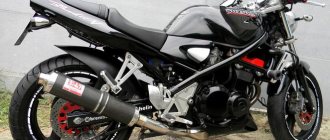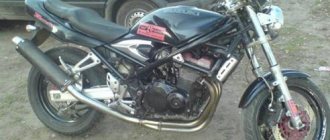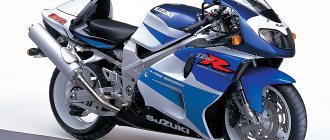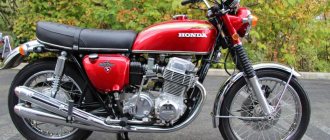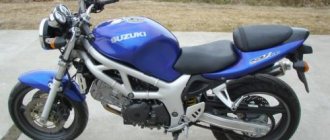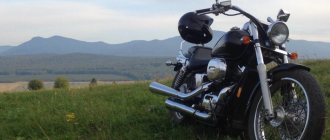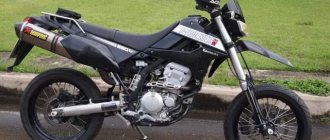The new model of the road motorcycle "Suzuki Bandit 600" was first presented to the public in 1995. She became the eldest in the GSF line. Having some common features with its predecessor, the Suzuki Bandit 400, the 600 was radically different from it. The main feature was the engine, which migrated from the Suzuki Katana, which at one time inherited it from an even older version - the GSX-R 750. Of course, the power unit underwent modernization, which resulted in a power of 77 hp. With. and 54 Nm of torque.
Other features of the Suzuki Bandit 600 include a steel duplex frame, laconic suspension in the form of a conventional telescopic fork and monoshock absorber, as well as a 6-speed gearbox.
Difficult character
It’s not in vain that even the advertising campaign reflects the connection to gangster romance, which is diligently hinted at by both the line’s designers and marketers developing advertising for the Suzuki Bandit-600 motorcycle. Photos showing the bike behind bars, and even with a weight fastened to the rear wheel, spread all over the world.
In general, neither the concept, nor the marketing campaign, nor any special performance characteristics in any way promote a criminal lifestyle and in no way contribute to it. Rather, the attachment to this image is more connected with daring, the desire for freedom, free impulses, road romance - in a word, with everything that one way or another characterizes the worldview of every biker.
Everything is not so clear...
Laudatory reviews from owners of the Suzuki Bandit 600 motorcycle periodically alternate with not too flattering ones. It is worth mentioning that some bikers see shortcomings in this model. The most common of them concerns the bike’s insufficient agility compared to expected. The owners are sure that this is due to the air-oil cooling of the engine and double rear shock absorbers.
Some people report that the fork is fragile, the stays of which can become seriously deformed even after a minor drop. Some people write about excessive overheating of the motor. The fairing also receives unflattering reviews, which is also not very durable.
Can all of the above become a serious argument against purchasing a Suzuki Bandit 600 motorcycle? Everyone answers this question for themselves. And those who have managed to get used to their “six hundredth” friend, even if they talk about some of his shortcomings, immediately explain that all of them can be easily eliminated. Moreover, the traffic of branded Suzuki spare parts is excellent. And service centers operate all over the world.
Appearance
The appearance of the bike matches the name. Its headlights, surrounded by plastic fairing, evoke associations with concentrated eyes visible through the slit of a balaclava.
By the way, not all models are equipped with a fairing. "Suzuki Bandit 600" was originally produced in two versions:
- GSF 600N - without fairing.
- GSF 600S - with fairing.
Otherwise, both versions are absolutely identical. They were distinguished only by the design of the “face”. The following photo allows you to verify this.
It is interesting that the Suzuki Bandit 600 motorcycle, the characteristics of which fully correspond to the definition of “classic”, also has clear features of a naked bike. They are expressed in obvious layout features. And the arguments for a classic start with the archaic air-oil engine and dual rear shock absorbers and end with the shape. Many experts considered this to be a flaw of the manufacturer, because from such a layout buyers expected much greater sporting agility, and not regularity. By the way, this became the impetus for the creation of the 650th version of “Bandit” in 2005, which replaced the “six hundredth” brother.
External features
The designers thought through the gangster look down to the smallest detail. Everything about its design speaks of dynamism. Today there are two versions of this model on the market, which differ from each other in one single spare part. The Suzuki Bandit 600 S comes with a small fairing, while the GSF 600N series models do not have one. Otherwise, both bikes are similar, like half-brothers. It’s hardly possible to say that this feature has such a strong impact on functionality. The fairing has more of a decorative function than a practical one, and often becomes the first object of tuning immediately after purchase. Which series looks cooler is up to the buyer to decide. It's just a matter of taste. But it is worth mentioning that the fairing gives the appearance of the bike a certain charm, giving its appearance gangster features. The paired headlights resemble eyes peeking through the slit of a balaclava, which is often noted by owners in their reviews.
If we consider only the appearance and do not take into account the performance characteristics, then the Suzuki GSF 600 Bandit cannot be called a 100% sport. It definitely has naked features. This, by the way, also works well for the overall style. The power units and the mighty V-shaped heart peeking out from under the plastic body kit look really cool.
Pages of history
Serial production and sales of the Suzuki GSF 600 Bandit started back in 1995. A year later, the S version was released - with a fairing. In 1999, the bike received a new rear shock absorber with preload and adjustable compression. The year 2000 was marked by many major updates. The Suzuki Bandit 600 has new plastic, a more modern front fairing, an upgraded carburetor with a throttle sensor, electrics, an additional air filter and brake calipers from Nissin. The capacity of the fuel tank has also increased - up to 20 liters. Thanks to carburetors, the maximum power increased to 80 hp. With. Since 2002, the model has included a fuel level sensor as standard. The fairing has also changed: its lines have become smoother.
TTX
The first thing a potential buyer of a Suzuki Bandit 600 motorcycle will decide to familiarize themselves with is the technical specifications.
| Full model name | Suzuki GSF 600 Bandit |
| Type | Road, naked |
| Years of production | 1995-2004 |
| Motor | Inline, 4-cylinder, 4-stroke |
| Volume | 599 cm3 |
| Frame | Tubular, steel |
| Fuel supply | Carburetor |
| Tank | 20 l (before 2000 - 19 l) |
| Ignition | Digital |
| Power (max.) | 80 l. With. |
| KP | 6-speed |
| Acceleration to hundreds | 4.1 sec. |
| Speed (max.) | 195 km/h |
| Dry weight | 204 kg |
Purpose
Beneath the typical naked exterior lies a sporty soul. Of course, first of all, the Suzuki Bandit 600 is intended for driving around the city and its environs. This model is most often chosen by residents of large cities who are accustomed to the fast pace of life. Conceived as a maneuverable vehicle for the street, it also performs well outside the city. Of course, too hilly or swampy terrain is too tough for him, and what on earth did he forget there? For off-road there are enduro and touring. But for those who like to test their strength in high-speed races, “Bandit 600” can simply be a dream come true.
He behaves quite tolerably on long journeys. It's silly to compare its comfort level to a cruiser. However, a trip to a neighboring city will not bring any significant inconvenience to either the pilot or the passenger. The sporty shape of the saddle will, of course, force you to take rests and stretch your stiff muscles. But, on the other hand, a frisky high-speed engine will significantly reduce the time required to cover the distance. An imposing cruiser will never keep up with the Japanese “Bandit”!
Test drive HondaHonda CB600F Hornet, SuzukiGSF 600 Bandit
There comes a time in the life of every, or almost every, motorcyclist when he grows out of the “short pants” of small-capacity equipment and takes his first step into the world of “adult” cubic capacity. Bikes with engines of about 600 cm3 are allowed into it.
The choice of models, types and styles in this cubic capacity is truly huge, so it can rightfully be considered “folk”. This time, two street cars fell into our raking hands: the Honda CB600F Hornet and the Suzuki Bandit 600. The choice of test vehicles was dictated by the fact that these are the most popular city cars with balanced characteristics, and have also gained enormous popularity over the years of production, becoming, I’m not afraid this word, cult. In addition, both models have recently been completely updated, which means that there will soon be plenty of Bandits and Hornets on the secondary market at very reasonable prices.
The Bandit 600 is a bastion of classic values. Tubular steel frame, round headlight and instrument wells. The lines of the tank flow gently, fading to nothing. Looking at the Bandit, you can't help but wonder, where are the good old pair of shock absorbers? Instead, you find a monoshock absorber and understand that this is still a child of our time, which means that the prefix “neo” is quite applicable to the title “classic”. There is a telescopic fork installed at the front and a steel pendulum at the rear. The power unit was a four-cylinder in-line engine from the Suzuki GSX600F. Equipped with air-oil cooling, it is known above all for its reliability and friendly character.
When Honda's Hornet (that's how Hornet is translated from English) stopped nearby, a feeling of deja vu appeared. A round headlight, instrument wells... A closer inspection prompted me to take away the “neo” prefix from the “suzuki son”. Look at Honda! Here, the basis of everything is a modern steel backbone frame, the engine is from a Honda CBR600F sportbike, brakes with four-piston calipers and a “silencer” pulled up aggressively under the tail. So what are you, a hero of our time? It should be said that, while Suzuki was a constant throughout almost its entire life, the Honda Hornet initially confused buyers, its ideological background was not entirely clear. Who needs a “naked” sportbike?! However, Honda brought this model to market at the perfect time. The Hornet became the forerunner of the naked class, and, in fact, the best-selling bike in the class. The Hornet cult is in no way inferior to the Bandit cult, and in terms of the amount of tuning and all sorts of baubles, the Hornet confidently outstrips most existing bikes.
Well, okay, let me sit and soak! Driving a Suzuki you feel at home. Even when you get behind the wheel of this motorcycle for the first time, you have no chance of running into any annoying moments in ergonomics. You sit upright, slightly leaning forward, contemplating the surrounding reality and instruments. By the way, here is the “sore” of the lack of a fuel level sensor, so be on the lookout, comrades. The footpegs are low, the steering wheel is optimal in width, so it seems there is nothing more to dream of.
Hornet greets the driver with a different interior. The body is tilted forward a little more, the steering wheel is narrower. I’m generally silent about the footpegs; they are located much higher and set back, which makes the landing feel more collected and even sporty. The prefix “neo” is clearly dominant on Hornet. The Honda's instrument panel is also modest, and this is surprising if only because the bike is ten years younger than its rival; they could have bothered with the fuel gauge! Is it possible that the Japanese never run out of gas and this information is really not relevant today?
The Honda engine starts smoothly and quietly. As if rustling, this in-line engine whispers at idle, without attracting any attention to itself. Bandit stands on less ceremony in this regard, because the air-oil-cooled engine itself is noisier than Honda’s “watery” engine, and the loud standard muffler also makes its contribution. Despite the fact that the engine capacity of the Honda Hornet is only 599 cubic meters, the clutch in terms of rigidity can compete with a motorcycle unit with a more solid “engine”. The forced need to “pump” the left hand is compensated by the soft and perfectly precise operation of the six-speed gearbox. Accompanied by the steady hum of the engine, we begin to move. Up to 6000 rpm. The Hornet is no different from a dozen competing motorcycles. The engine's operation is soft, vibrations are zero, however, acceleration is also not inspiring. But, as soon as the tachometer needle crosses this mark, you receive proof that deboosting the power unit in order to saturate the torque in the middle of the range has fully justified itself. The acceleration dynamics are excellent, but... Providing acceleration to “hundreds” in just over 3 seconds, the ex-Honda CBR600F engine with some of the horses left somewhere the emotions, the very feeling of speed. Everything happens so smoothly that you subconsciously want to turn the throttle back even more... But in fact, the speed has long ago exceeded all reasonable limits. Bandit is a completely different matter. Definitely inferior to the Honda both in dynamics and in the elasticity of the power unit, it is rehabilitated thanks to the excellent soundtrack.
The owner of the Suzuki Bandit said that the acceleration on his motorcycle is dramatic, and it is! The bike makes so many mechanical noises and sounds that there is no doubt about its ability to at least go into orbit! The chassis is also not far behind: it lacks rigidity, so it feels like you’re going to the limit. A real fan machine in terms of external effects, but not in terms of content. This becomes especially obvious when the straight ends and the turns begin. You instantly taste the “delights” of a conservative tubular frame, which discourages you from being “nimble” in turns. On the other hand, before you can complain about the rigidity of the frame, you will have the opportunity to listen to the grinding of the center stand, which comes into contact with the asphalt long before the lean angle becomes anything aggressive. As you might imagine, the Hornet, with its rigid frame, high-mounted pegs and complete lack of a center console, behaves completely differently: high-speed cornering on a Honda is a pleasure.
Although here, not everything is so chocolate: the Hornet lacks the fork stiffness, so drivers with an aggressive driving style and the proper level of skill will have to take care of replacing the fork springs with stiffer ones. The rear monoshock behaves better, although there is still room for improvement here. As you already understand, the Suzuki Bandit 600 in this pair is clearly not a driver’s bike, so we’d better enjoy the comfort that fairly soft suspensions provide on our roads. They readily swallow bumps on which the Hornet shudders with its entire “body.” You can ride the Bandit freely without rushing, it does not provoke the driver. Hornet is clearly not the most “biting” of hornets (the soft suspension and boring engine allow it to do so), but its character is generally sportier and, if you like, more aggressive. This is especially felt on this example, which, in addition to everything, is also decorated with magnificent airbrushing.
In the meantime, our joyful rides were unceremoniously interrupted by State Traffic Inspectorate cars, which blocked all the roads adjacent to the Boryspil highway. We were already depressed, but the servicemen reassured us, saying that delivering the dignitary “body” to the airport would not take more than half an hour. We spent this half hour usefully, testing the braking dynamics of both bikes directly. As for the Bandit, its brakes, with 290mm discs and two-piston calipers, do not grab the stars from the sky and match the calm nature of the motorcycle. The 296 mm Honda Hornet brakes left a completely different impression. Perhaps the brakes from Nissin are the most sporty element of the bike and fully correspond to the image of a street fighter. They are informative (although installing reinforced hoses has never hurt anyone) and provide powerful and predictable deceleration, which is good news.
On the way home, the thought occurred to me that it looked a little like an illustration for a martial arts tutorial. “Hornet attacks the black Bandit,” that would be the title of this section.
But seriously, despite the fact that ideologically and structurally these bikes differ more than seriously, any of them can be safely recommended for “upgrading in class.” The Suzuki Bandit 600 turned out to be a real sweetheart and is perfect for inexperienced or calm drivers. In addition to its friendly nature, its reliability and relatively low price will come in handy. The Honda CB600F Hornet is cut from a different cloth. With his entire appearance, he declares serious potential (in addition, he is the founder of the street fighter class!). At the same time, this “Hornet” is not “biting”, and certainly will not try to sting its owner, so it is highly recommended for motorcyclists with a sporty streak, as well as for tuning enthusiasts. Honda's reliability is also without question. It would not hurt to install a glass on both bikes, which will increase their “long-range” potential, and also make riding at speeds “over 140” much more pleasant... That seems to be all.
The choice is yours, dear friends!
Suzuki Bandit owner's opinion: Alexander Gritsai
When you put both motorcycles side by side, you realize that the Bandit design is at least 5 years older. At the same time, it would be hard to call it obsolete. Personally, I really like the thin-finned engine, the specific shape of the gas tank, the steel duplex frame, and the fact that visually the “Bandit” looks more massive than the Honda. Honda has its own advantages: it looks more modern, faster, more compact and certainly... angrier. There are set-back footpegs, a high-mounted muffler, and a lower fork angle. This is an aggressive insect. But if we take it as a whole, then, in my opinion, it is “Bandit” that looks more harmonious. Classic neoclassic! In terms of comfort, the undisputed leader is Suzuki. The seating position is classic, the steering wheel is generally very comfortable. The bandit also has a center stand, which, in my opinion, is very convenient. As for dynamics, I give the championship to Honda, but I note that in terms of ride comfort it is inferior to my Bandit. Would I agree to change my Bandit? Yes, but not on Hornet. I like the big Bavarian boxer Olrounders. I'll buy one of them.
And Bandit is my first motorcycle and it played its role perfectly. It is easy to operate, obedient and unambiguous in its reactions. And it's also more comfortable. Low flights, both in the city and on the highway, are not for him. To be honest, the purpose of the Honda Hornet remains a mystery to me. For the money that dealers are asking for it, you can buy any “sport 600”, but at least it’s clear what all this toughness is for. In Hornet - for the life of me, it’s unclear. Yes, Suzuki is generally simpler. But it is more harmonious. Bandit is a complete nature, a personality, but Hornet, despite many advantages, does not fit into a holistic image.
Text: Denis Los, Valera DRIVE
Photo: michel
Weak sides
It is worth mentioning the disadvantages of the Suzuki Bandit 600 model. Owner reviews often indicate the following:
- After a fall, the fork legs may become deformed.
- The engine is prone to overheating in hot weather, this is especially noticeable in city traffic jams.
- The plastic fairing is not very reliable. Once you drop a bike on it, it cracks and bends.
- After approximately 20-30 thousand kilometers, the resource of the rear shock absorber comes to an end.
- It is difficult to feel the moment of wheel locking with the rear brake.
However, the same motorcycle owners write that all the bike’s problems can be solved. This is greatly facilitated by the wide network of Suzuki service centers, the availability of spare parts, and ample opportunities for tuning.
"The Six Hundredth Bandit" and its owner
The Suzuki Bandit 600, whose technical features clearly place it in the sports class, will definitely appeal to those who like to drive along the city streets, and sometimes go beyond it. Many owners who have ridden hundreds of miles on the Bandit testify that the seat in the saddle is quite comfortable, the body does not become stiff, which makes this vehicle suitable for long roads. You shouldn’t, of course, think that you can ride it on a real long-distance motorcycle road trip for several weeks and drive a thousand kilometers a day. It is still not designed for such loads.
It’s also unlikely that you’ll be able to ride it in a suburban setting. The Bandit can handle some bumps, but on serious obstacle courses any enduro and even an enduro tourist can easily bypass it.
But why use a beautiful sports bike for other purposes? His place is in the city, it is there that he can show his full potential. It will easily get out of a traffic jam, go around an obstacle, and show the remarkable performance of suspensions on paving stones. In addition, its owner will be able to demonstrate his daring by getting ahead of the rest of the traffic at the intersection. By the way, you can accelerate the bike to hundreds in just 4.1 seconds.
The Suzuki Bandit 600 often becomes the choice of those who already have experience driving motorcycles and have “outgrown” a sports small car, but have not yet matured to “1000+”. Sometimes it is chosen by former tourists who want speed, or by enduro enthusiasts who are tired of their crazy pace. In short, “Bandit” rarely becomes the first motorcycle and most often ends up under the saddle of an experienced rider.
Fuel and consumables
Let's face it, the bike has absolutely average performance in terms of weight, speed, and fuel consumption. Don't expect miracles from him. Of course, a lot depends on the driving style, temperature, the weight of the pilot with passengers and luggage, the quality of the road surface and much more. On average, plan to spend about 6.5 liters for every hundred kilometers.
Don’t start the bike, take care of its technical condition, change the oil on time and try not to skimp on the quality of gasoline. All this will reduce fuel consumption, assure the owners of the “bandit”
Photo gallery
All of the above qualities make the GSF600 a reliable companion on any road, giving the pilot a feeling of reliability and confidence and not requiring the skills of a professional racer. But you can judge his external data for yourself after viewing our small photo selection.
Tuning options
The manufacturer offers many spare parts that can be installed on the Suzuki Bandit 600 optionally. Reviews from owners most often describe replacing the steering wheel, upgrading the plastic body kit and wind protection.
The fairing is often subject to tuning. This makes it possible to install additional protection on the headlight. Replacing the windshield with a larger one allows the pilot to withstand speeds above 140 km/h better and longer. Judging by the reviews, it’s not so easy with your native one.
Modernization can also affect the saddle. This is especially true for those who often carry passengers - as on most sports bikes, the original rear seat of the Bandit is quite modest.
Wide possibilities for tuning and well-established traffic for the supply of original spare parts - all this provides the opportunity for each owner to customize his favorite “horse” for himself, taking into account all tastes, requests and needs.
A few words about competitors
When choosing a motorcycle, a future buyer often looks at models with similar characteristics in the same price segment. The Honda Hornet CB600 is a serious competitor to the Bandit. Diversion and Fazer motorcycles from Yamaha are attracting well-deserved attention. “Bandit” also has a half-brother who can take away his fans - the Honda CBF 600″.
In many ways, these sportbikes are similar, but each of them has a number of its own features. Evaluate your own preferences, rely on reviews from owners, compare and analyze - then when you buy, you will have no doubt that you got the best bike.
